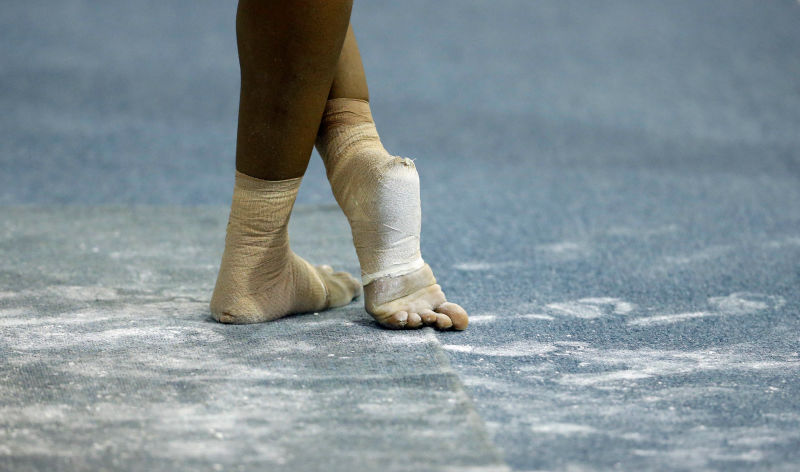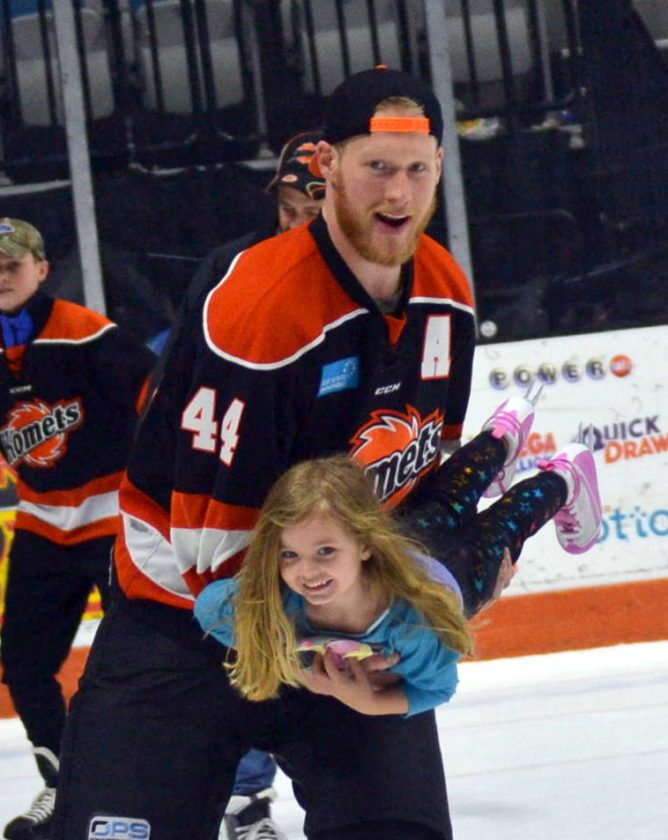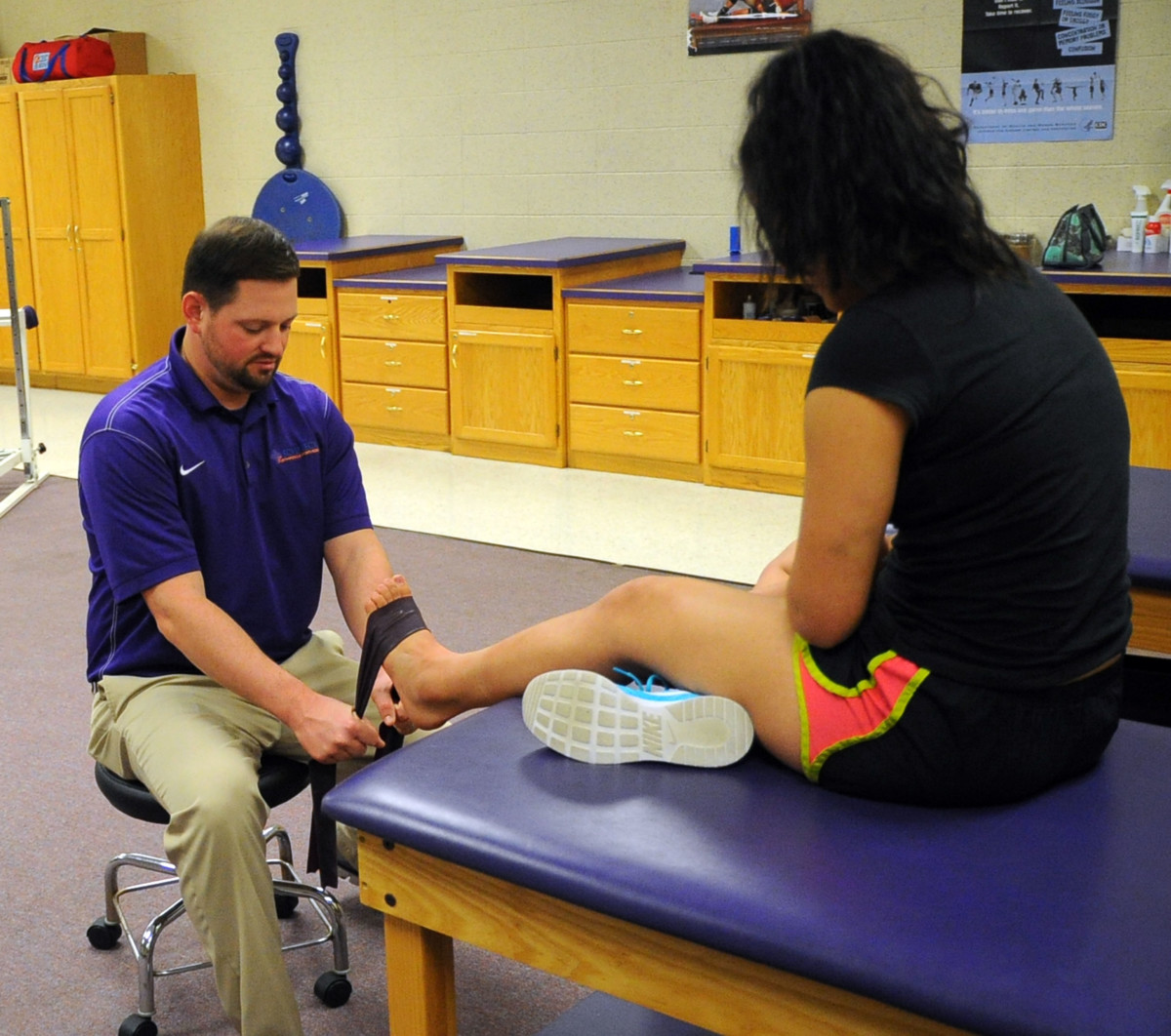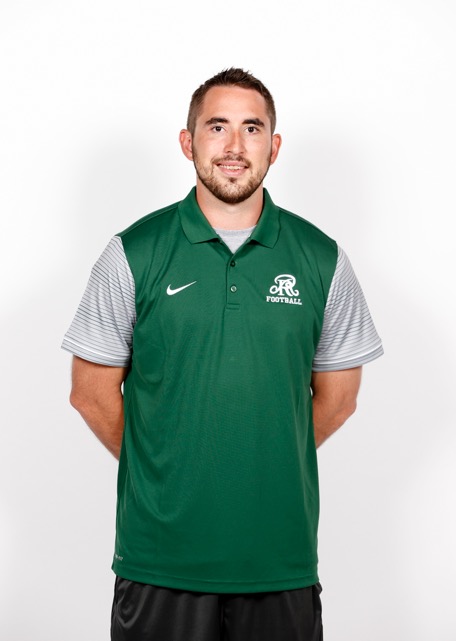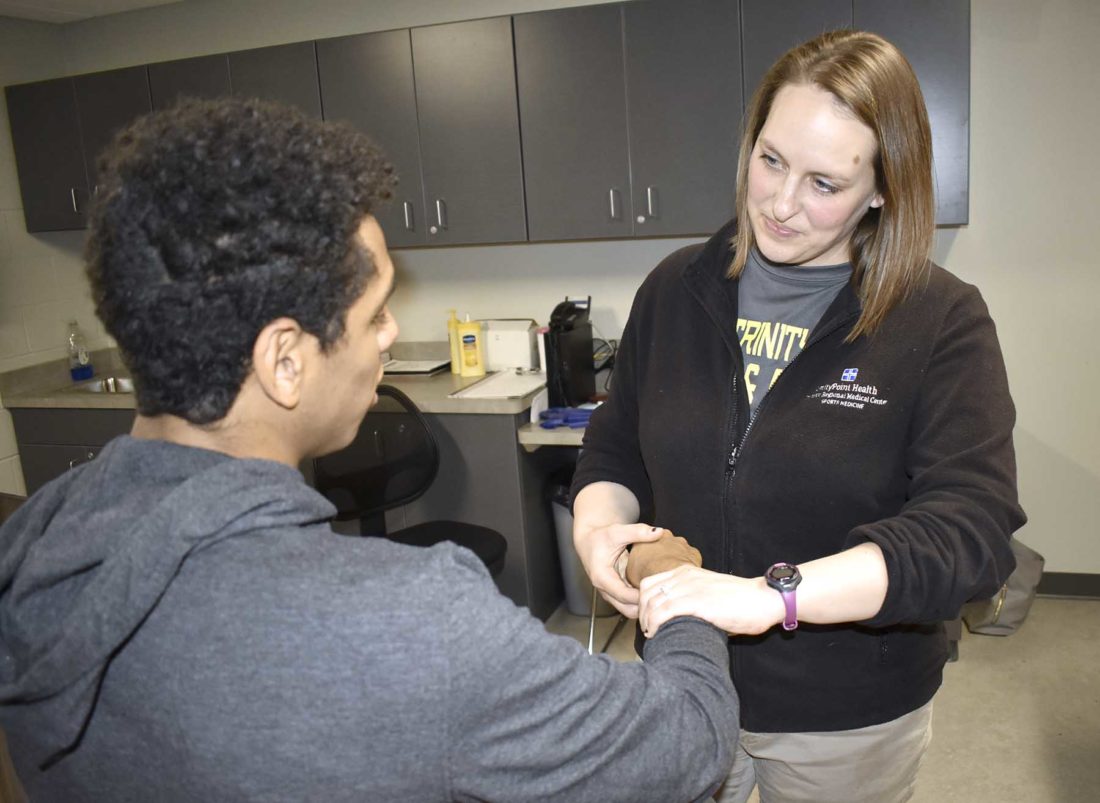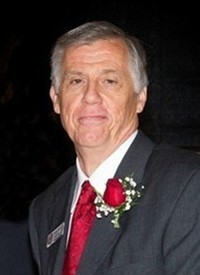-Messenger photo by Chad Thompson Bre Drees, an athletic trainer for UnityPoint Health, assesses the wrist of Brayden Bell, 17, a senior at Fort Dodge Senior High, recently.
When a cross country runner suffers a gruesome leg injury or a football player is forced from action after a taking big hit, Bre Drees is often the first one to provide medical aid.
Drees, of Fort Dodge, is a full-time athletic trainer for UnityPoint Health.
She is also a part-time health instructor at Fort Dodge Senior High.
“Depending on the time of day, it’s two different jobs,” she said.
Most of the time, Drees can be found on the sidelines during FDSH sports practices, games, and meets.
-Messenger photo by Chad Thompson Bre Drees, an athletic trainer for UnityPoint Health, prepares her medical bag at Fort Dodge Senior High recently.
“I am there to take care of any injuries that the athletes might suffer,” she said. “Treat them. Evaluate them.”
Her goal is to return the athletes to play as quickly and safely as possible, she said.
She also helps the injured by stretching them, taping them up, and providing them with heat or ice.
“I am going to do all four of those things every day,” she said. “That’s a given.”
During winter sports, Drees walks from gym to gym to check in on practices.
She watches basketball, wrestling, and swimming.
In the fall, Drees spends most of her time at football practices. Other times she attends volleyball practice.
“Football has more athletes and higher risk of injury,” she said.
The most difficult time of year for her to balance her schedule is the summer.
“The toughest is when baseball and softball is going on because they are so far apart,” she said. “For them, the risk of injury is pretty equal, so I split my time between the two.”
Drees’ personal experience in sports contributed to her interest in athletic training.
“I was always interested in the medical field since I was a small child, but being an athlete I also really enjoyed sports,” she said. “This was one of the professions I could pursue to combine those two passions.
She added, “When I was in high school my brother had a severe leg injury in football and kind of watching him go through the whole process of returning to play got me more interested in sports medicine.”
Drees was the first eighth-grade pitcher to start for a state championship team. She pitched for Webster City High School in 2001.
While in high school she also played basketball, volleyball, and ran track.
She also pitched in college.
Drees was born and raised in Webster City. She graduated from Webster City High School in 2005.
She earned her bachelor’s degree in athletic training from Luther College in Decorah in 2009.
In 2011, she graduated from Western Illinois University in Macomb, Illinois, with a master’s degree in kinesiology.
She was hired by UnityPoint Health two days after her graduation.
In 2012, she began teaching at the high school.
She teaches two classes a day in the subjects of athletic training, health care, and coaching.
One of the most difficult aspects of her job in athletic training is trying to help a large number of athletes in a short amount of time, she said.
“Treating so many athletes in a really short time because they are in school all day and then they go directly to practice,” Drees said. “They are so busy, it’s hard to find the time to work in depth with them.”
Back injuries and ankle sprains are two of the most common injuries, according to Drees.
“Ankle sprains we can usually treat and get back out to play, where back injuries and knee injuries can sideline people for a while,” she said.
Drees said broken bones and neck injuries are some of the worst injuries she’s seen.
At state cross country, for example, she has had to treat severe broken legs.
She said the bigger events can be more of a challenge to work.
“Trying to keep the athlete calm, the family calm,” Drees said. “There’s always fans around that see it and emotions are always high during state events.”
Sometimes during games and meets, athletes aren’t the only ones who need Drees’ assistance.
“I’ve treated a lot of fans and spectators,” she said. “That’s one thing people don’t realize we do a lot of.”
From little kids with broken fingers to someone getting hit with a foul ball, Drees has to be ready for just about anything.
“I’ve had two instances where a moth was stuck in someone’s ear,” she said. “The one moth we got out with tweezers. The other had to be flushed out. We had to call the ER.”
Drees has even helped a spectator from out of town.
“Her husband sent me a really nice card for helping take care of his wife,”Drees said. “He went out of his way. He didn’t know me, so he had to look me up to even send the card. To go out of his way to send that to me made me feel like my job was more meaningful.”
In terms of treating athletes, one hot button issue is how concussions are handled.
Drees follows a mandated concussion protocol that all high school athletes have to follow.
“I would say the concussion testing is more thorough now,” she said.
Much of the testing is completed on a computer, she said.
Once a player is diagnosed with a concussion, they are required to complete a seven-step process, according to Drees.
“It starts out with complete rest until they are completely asymptomatic,”she said. “Once the symptoms have gone away, they get them back into school for a day without any symptoms.”
After that the player runs a jog, then sprints, and then they are allowed to get into team drills, she said.
“The sixth step is a full practice and the seventh step is returning back to competition,” Drees said.
There has to be a minimum of 24 hours between each step.
CTE, or Chronic Traumatic Encephalopathy, is a progressive degenerative disease of the brain that can impact athletes who have suffered from repeated hits.
There is a lot of uncertainty surrounding the disease, according to Drees.
“We still don’t know a whole lot about it,” she said. “There is always learning to do and research to learn about. I think because of how public it is now and how often it’s in the news, more people understand the risk of concussions, so athletes and coaches are more likely to report to me if they feel like an athlete has suffered a concussion, whereas maybe five to 10 years ago they were more likely to hide it or play through it.”
She said the only way to diagnose CTE is through an autopsy.
“A lot of research is how do we diagnose this with someone who is living,”Drees said. “Another thing is how do we prevent it, which is harder to do.”
Some athletes she has treated have already suffered multiple concussions, she said.
“They are the ones more likely to ask about CTE and at what point do they stop playing,” she said. “How many is too many, and we really don’t have an answer.”
Meanwhile, Drees said she tries to educate athletes on the risks involved with playing contact sports.
One of the first things Drees had to do when she began her career was to build trust with athletes.
“Knowing they can come to me with injuries and trust that I will take care of them,” she said. “I am not going to hold them out for no reason. They don’t want to say anything because they think I won’t let them play. Building that relationship is the biggest thing for an athletic trainer.”
Drees said one of her main focuses will be on how to prevent certain types of injuries.
“Whether that’s through strength and conditioning or specific exercises to prevent knee and ankle injuries, or whatever it might be,” she said.
When Drees isn’t busy at FDSH, she also serves as a health coach for hospital employees and their spouses.
“We sit down and talk about their lifestyle and what goals they want to set as far as eating better, decreasing stress, and being more physically active, and try to come up with ways to meet those goals.”
Drees said Fort Dodge has been a good home, which did surprise her a little, she said.
“Honestly growing up in Webster City, I didn’t have the best image of Fort Dodge,” she said. “It was a place you heard about the bad things, but not the good things.”
“I didn’t really know about the good things until I lived here for a while,”she added. “I think a lot has changed, but a lot of it was that misconception of what Fort Dodge was really like growing up. Now that I am living here, I really enjoy it. It’s a lot better place than what people make it seem like.”
